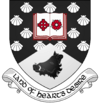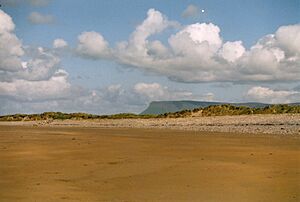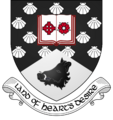County Sligo facts for kids
Quick facts for kids
County Sligo
Contae Shligigh
|
||
|---|---|---|
|
||
| Nickname(s):
Yeats Country
|
||
| Motto(s):
Land of Heart's Desire
|
||
| Anthem: "Isle of Innisfree" and "Down by the Salley Gardens" |
||
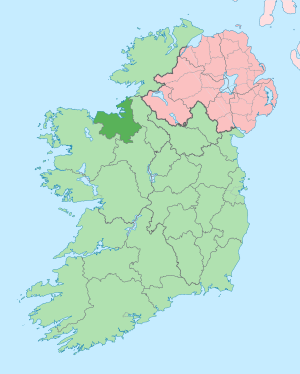 |
||
| Country | Ireland | |
| Province | Connacht | |
| Region | Northern and Western | |
| Established | 1585 | |
| County town | Sligo | |
| Area | ||
| • Total | 1,837 km2 (709 sq mi) | |
| Area rank | 22nd | |
| Highest elevation | 647 m (2,123 ft) | |
| Population
(2022)
|
||
| • Total | 70,198 | |
| • Rank | 27th | |
| • Density | 38.213/km2 (98.972/sq mi) | |
| Time zone | UTC±0 (WET) | |
| • Summer (DST) | UTC+1 (IST) | |
| Eircode routing keys |
F56, F91 (primarily)
|
|
| Telephone area codes | 071 (primarily) | |
| Vehicle index mark code |
SO | |
County Sligo (pronounced SLY-goh) is a county located in Ireland. It is part of the Connacht province and the Northern and Western Region. The main town and administrative center is Sligo. The local government for the county is Sligo County Council. In 2022, about 70,198 people lived here. County Sligo is famous for Benbulben Mountain, which is one of Ireland's most recognizable natural landmarks.
Contents
History of County Sligo
County Sligo was officially created in 1585. However, it truly began to take shape after a major conflict called the Nine Years' War ended in 1603. The county's borders were based on the old territories of a group called the Ó Conchobhair Sligigh in an area known as Lower Connacht.
These territories were later divided into smaller areas called baronies. The main town of the newly formed county was Sligo.
Long before the county was formed, people lived here. In 2003, a very old farming site was found at Maugheraboy. This shows that farming began on the Cúil Irra Peninsula a long time ago. Nearby, the Carrowmore megalithic cemetery is a huge collection of Stone Age monuments. These ancient sites connect to other important places like Carrowkeel and Knocknarea Mountain, where a famous passage tomb named after the legendary Queen Maeve stands.
The Caves of Kesh, which are well-known in Irish stories, are also in County Sligo. Many important medieval books were written here, including the Book of Ballymote and the Great Book of Lecan.
Culture and Arts
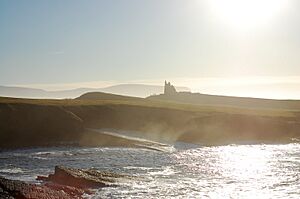
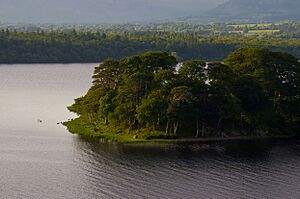
County Sligo is a very important place in Irish myths and legends. Many stories from the Mythological Cycles are set here. For example, the famous tale of Diarmad and Grainne ends on Benbulben Mountain. The area's many ancient monuments have inspired artists and writers for centuries.
The famous poet and Nobel Prize winner W. B. Yeats (1865–1939) spent much of his childhood in northern Sligo. The beautiful landscapes of the county, especially the Isle of Innisfree in Lough Gill, inspired many of his poems. Yeats once said that Sligo was "the place that has really influenced my life most." He is buried in North County Sligo, "Under Ben Bulben" in Drumcliff. His brother, Jack, who was a painter, also found inspiration in Sligo's scenery.
Music Scene
County Sligo has a rich history of traditional music. The southern part of the county is especially known for its musicians. Famous traditional artists like Michael Coleman, Paddy Killoran, and James Morrison came from here. Today, the county still has many traditional music festivals. One popular event is the Queen Maeve International Summer School, which teaches Irish music and dance every August in Sligo Town.
For more modern music, the popular pop band Westlife is from Sligo. Other artists like Tabby Callaghan and The Conway Sisters also have roots here. Each year, Strandhill hosts the Strandhill Guitar Festival, showcasing different types of guitar music.
Sports in Sligo
County Sligo is home to Sligo Rovers, a professional football club. They play their home games at The Showgrounds and have won the league three times. Their team colors are red and white, which is why they are nicknamed "the Bit 'O' Red." Brother Walfrid, who founded the famous Celtic Football Club in Scotland, was born in Ballymote in County Sligo.
In Gaelic Games, the county is represented by Sligo GAA. Their team colors are black and white. Sligo has won the Connacht Championship in Gaelic football three times.
Geography and Towns
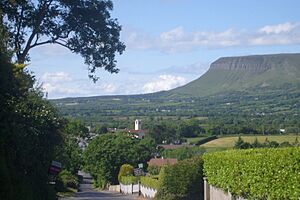
Sligo is the 22nd largest county in Ireland by area and the 27th largest by population. It is the fourth largest of Connacht's five counties in size. County Sligo shares borders with County Mayo to the west, County Roscommon to the south, and County Leitrim to the northeast.
Largest Towns in County Sligo (2016 Census)
Here are the largest towns in County Sligo based on the 2016 census:
- Sligo, 19,452 people
- Tubbercurry, 1,986 people
- Strandhill, 1,753 people
- Collooney, 1,610 people
- Ballymote, 1,549 people
- Ballisodare, 1,350 people
- Enniscrone, 1,223 people
- Coolaney, 990 people
- Rosses Point, 883 people
- Grange, 586 people
Places of Interest
County Sligo has many interesting places to visit, including:
- Benbulbin (a distinctive mountain)
- Carrowkeel Megalithic Cemetery (ancient burial sites)
- Carrowmore Megalithic Cemetery (one of the largest megalithic cemeteries in Ireland)
- Caves of Kesh (famous in Irish mythology)
- Coolera Peninsula (a scenic coastal area)
- Curlew Mountains
- Dartry Mountains
- Glencar Lough (a lake with a famous waterfall)
- Knocknarea (a mountain with Queen Maeve's cairn)
- Lough Arrow
- Lough Gill (a beautiful lake)
- Mullaghmore Peninsula (known for its coastline)
- Ox Mountains
- Rosses Point Peninsula (a popular seaside village)
- Sligo Abbey (historic ruins)
Famous People from County Sligo
Many notable people have come from County Sligo:
- Brother Walfrid (1840–1915) – He was the founder of Celtic Football Club, a famous team in Scotland.
- W. B. Yeats (1865–1939) – A world-famous poet who won the Nobel Prize. His childhood in Sligo inspired much of his work.
- Constance Markievicz (1868–1927) – An important Irish nationalist and the first woman ever elected to the British Parliament.
- Jack Butler Yeats (1871–1957) – A well-known artist and brother of W. B. Yeats.
- Michael Coleman (1891–1945) – A legendary traditional Irish fiddler.
- James Morrison (1893–1947) – Another highly influential traditional Irish fiddler.
- Ray McSharry (born 1938) – A significant Irish politician who served in various important roles.
- Neil Jordan (born 1950) – A talented film director and writer.
- Pauline McLynn (born 1962) – An actress famous for playing Mrs. Doyle in the TV show Father Ted.
- Tommy Fleming (born 1971) – A popular Irish singer.
- Shane Filan (born 1979), Kian Egan (born 1980), and Mark Feehily (born 1980) – All members of the hugely successful pop band Westlife.
- Christopher O’Donnell (born 1998) – An Olympic track and field athlete.
Railways
The main railway line in County Sligo is the Dublin–Sligo railway line. It connects Dublin Connolly station to Sligo Mac Diarmada railway station in Sligo. There are also train stations in the county at Ballymote and Collooney.
Images for kids
See also
 In Spanish: Condado de Sligo para niños
In Spanish: Condado de Sligo para niños


